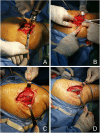Hemiarthroplasties via Posterior Trochanter Osteotomy for Treating Femoral Neck Fractures in Post-Cerebrovascular Disease
- PMID: 40530244
- PMCID: PMC12170355
- DOI: 10.2147/JMDH.S515576
Hemiarthroplasties via Posterior Trochanter Osteotomy for Treating Femoral Neck Fractures in Post-Cerebrovascular Disease
Abstract
Objective: The study investigated to examine the clinical outcomes of hemiarthroplasties using posterior femoral trochanter osteotomy for the treatment of femoral neck fractures in patients at the sequelae stage of cerebrovascular disease.
Methods: A retrospective analysis was conducted on the data of 53 patients who had been admitted to the Department of Orthopedics at Yan'an University Affiliated Hospital between May 2020 and May 2023. These patients had been diagnosed with femoral neck fractures and concurrent muscle weakness at the sequelae stage of cerebrovascular disease. The patients were divided into two groups: the osteotomy group (20 cases), which underwent hemiarthroplasties via an L osteotomy of the posterior femoral trochanter, and the conventional group (33 cases), which received hemiarthroplasties through the posterolateral approach of the greater trochanter. The two groups were compared on various parameters, including incision length, operation duration, intraoperative blood loss, postoperative drainage, blood transfusion rates, length of hospitalization, early mobilization post-surgery, hip joint function scores at follow-up visits (3 and 12 months), and the rate of postoperative dislocation of the femoral head.
Results: No significant differences were observed between the two groups regarding incision length (P=0.06), operation duration (P=0.284), intraoperative blood loss (P=0.925), Blood transfusion rate (P=0.489), postoperative drainage (P=0.831) and length of hospital stay (P=0.341). However, the early mobilization time following surgery was shorter in the osteotomy group compared to the conventional group (P<0.001). Additionally, the Harris hip joint function scores for the osteotomy group were significantly higher than those for the conventional group at both the 3- and 12-month postoperative assessments (P=0.003, P=0.004, respectively). The dislocation rate of the femoral head in the osteotomy group was lower than that in the conventional group with no statistical significance difference (P=0.521).
Conclusion: The use of hemiarthroplasties via posterior femoral trochanter osteotomy demonstrates favorable clinical outcomes in the treatment of femoral neck fractures.
Keywords: femoral neck fractures; hemiarthroplasty; osteotomy; stroke; surgical procedures.
© 2025 Jia et al.
Conflict of interest statement
The authors declare that they have no competing interests.
Figures




References
LinkOut - more resources
Full Text Sources

